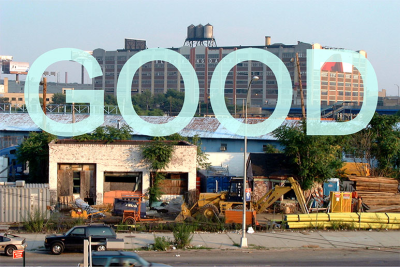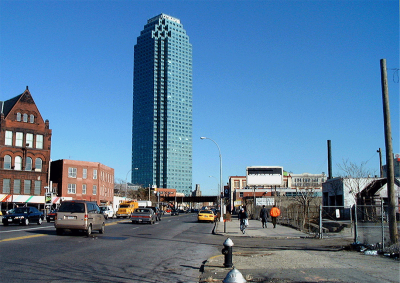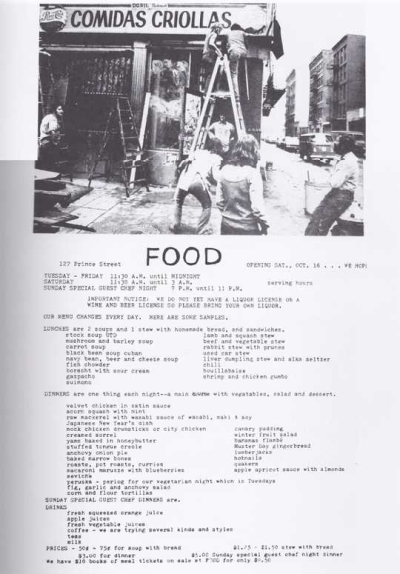
*
GOOD
project for Public Art Fund (not realized)
2000
GoodIn 2000, on the invitation of the Public Art Fund in New York City, we formulated GOOD. With this project we proposed transforming a site with a house and garage on Jackson Avenue, Queens, into a temporary meeting place and workspace for artists.
The garage was situated on a desolate piece of wasteland, which was being used as a dumping ground for refuse from road construction, cables and drainpipes. This site immediately attracted our attention when we arrived at P.S. 1 in September 2000 - as we always have our eyes peeled for redundant spaces and niches.
The small house with its over-sized garage was completely without glamour and as ordinary as the suburban dream; an utterly non-place begging to be deciphered and reconstructed.
GOOD's strategy is to reinvent free spaces: almost against our better judgment, though not naively, as we are all 'loaded' with our own and other's knowledge, experience and history of the last few decades. The Public Art Fund itself was a crucial component in the project proposal. The creation of free spaces, or sanctuaries, has been one the most powerful ventures undertaken by artists since 1945. It has provided other
artists with a way to step outside the traditional art circuit and to become self-determining. Located opposite the large art institution PS1 (itself at one time a 'free space') this pathetic little house becomes a mirror to this institution.
By using, and negotiating with, the official platforms and through official channels, the 'inside' and 'outside' of various spaces where art can take place is constructively problematised; free space becomes transformed into a working strategy.
The idea of alternative spaces not only relates to architecture, but also is aimed at generating a mentality or ideology as an alternative to the market-driven gallery system on the one hand and the intransigence of museum spaces on the permanent versatility, temporariness and movement are indispensable components of free space.
After the restoration of essential facilities, GOOD should come to function as an open space where people could work, discuss and present, using the existing architectural space to revitalize memory in the present.
This reusing of space does not stem from nostalgic desire, but is sparked by the understanding that things

lie concealed in the folds of recent history. They have to be actively exposed in order for us to be able to move on. To resist memory loss and to avoid falling into the trap of repetition, conservatism or even fundamentalism, people' s activities (which after all make and determine history) must first be consumed and digested. In this way progression and change can truly be generated and made possible. The implications of the notion of 'possession' or 'ownership' are reversed and turned inside out by again using deserted or 'uninteresting' places. Not by adding yet another new idea to the cycle of production and consumption, but by revising an existing situation. Reconstruction as opposed to destruction.
The house, which should be open 24-hours-a-day, challenges the meanings of such things as ownership rights, openness, responsibility, trust and even vandalism, by literally, consciously, and deliberately making the space vulnerable, and open to everyone. Information and gathered knowledge about urban developments and the idealized New York art scene of the 1960s and 1970s can be brought into focus in this space, thereby establishing connections with the recent past, as well functioning as a laboratory for new ideas and practices of the future.
* The name GOOD is derived from FOOD.
FOOD was the name of the restaurant opened in 1971 by Gordon Matta-Clark, Caroline Goodden, Tina Girourd, Suzanne Harris and Rachel Lew at 127 Spring Street, New York. To show and document their work, to support themselves and others, these artists organized themselves into a cooperative community network which led to FOOD becoming the meeting place and centre of discussion.
The group was also responsible for the founding of the magazine Avalanche, the performance and exhibition space 112 Greene Street (from which later White Columns developed) and the think-tank Anarchitecture Group.
The location of the house diagonally opposite P.S.1 is perfect.
P.S.1 developed directly from the history and practices of alternative spaces: in the 1970s, the strategy of the Institute for Art & Urban Resources, which Gordon Matta-Clark was closely involved with, occupied empty spaces in the city and made a major contribution in that period to a highly active and inspiring artistic climate. GOOD raises the issue if such a climate is still possible today. While asking it may stimulate the emergence of such a climate.
